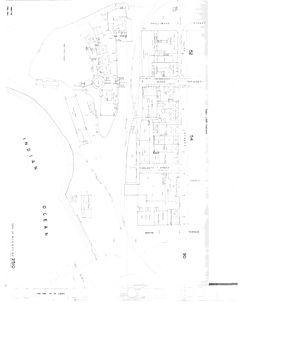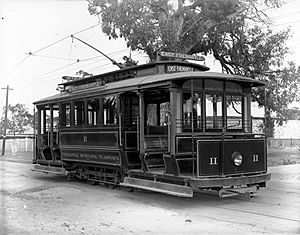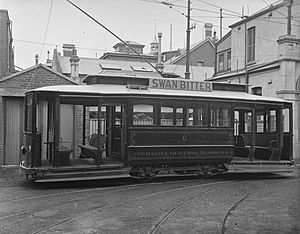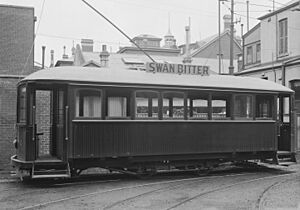Trams in Fremantle facts for kids

Fremantle Municipal Tramways opening day, 30 October 1905
|
|||
| Operation | |||
|---|---|---|---|
| Locale | Fremantle, Western Australia | ||
| Open | 30 October 1905 | ||
| Close | 8 November 1952 | ||
| Status | Closed | ||
| Routes | 6 | ||
| Owner(s) |
|
||
| Operator(s) |
|
||
| Infrastructure | |||
| Track gauge | 3 ft 6 in (1,067 mm) | ||
| Propulsion system(s) | Electricity | ||
| Electrification | Overhead catenary | ||
| Depot(s) | High Street | ||
|
|||
The Fremantle tramway network was a system of electric trams in Fremantle, a port city in Western Australia. These trams connected the city center to nearby areas. It ran from 1905 to 1952. This tram system was separate from the larger Perth tram network.
Contents
History of Fremantle Trams
The Fremantle Municipal Tramways (FMT) started running on October 30, 1905. Before this, Fremantle had no public transport. The tram lines grew, reaching North Fremantle in 1908 and Melville in 1915.
The North Fremantle line closed in 1938. It was replaced by diesel buses. The rest of the tram network was used a lot during World War II.
After the war, the tram system made good money for the local council. However, the State Government decided to take over electricity systems in the early 1950s. This meant the price of electricity for the trams went up a lot. It became very expensive for the council to run them.
Because of this, the entire tram system closed down. The last tram ran into the Carbarn on Queen Victoria Street on November 8, 1952. The very last Fremantle tram left the town on a large truck in March 1953.
Tram Routes and Services
Original Tram Lines
By April 1906, Fremantle's tram network was fully working. It had four main lines:
South Line (Route S)
This line went along High Street, through a city loop, then South Terrace to Douro Road in South Fremantle. It connected central Fremantle to South Beach.
During the week, people used it to get to Fremantle for work. On summer weekends, people came from Perth to ride this line to South Beach. From 1907, the line included a short loop past the Fremantle railway station.
In 1923, South Beach added new facilities, like a Hydrodome. The South line stayed open until the entire tram network closed in 1952.
East Line (Route E)
This line started on High Street, went via Adelaide Street and Canning Road (now Canning Highway) to Allen Street in East Fremantle. In 1909, it was extended to Petra Street.
On December 15, 1915, the Melville Roads Board opened another extension. This went along Canning Road to Stock Road in Bicton.
Marmion Line (Route M)
This line ran from High Street, Fremantle, along Marmion Street to Duke Street in Marmion (now part of East Fremantle). In 1908, this line was extended further along Marmion Street.
It then turned south to High Street. It continued east to a new end point at the Fremantle Cemetery on Carrington Street. The line along Marmion Street was also later extended to McKimmie Street in Palmyra.
Beaconsfield Line (Route B)
This line started on High Street, Fremantle. It went along Hampton Street (now Hampton Road) to the Beaconsfield public school. This was at the corner of Lefroy Road in Beaconsfield.
This line was later extended along Hampton Street, Wray Avenue, and South Street. It reached Central Avenue and then Carrington Street in Beaconsfield. This line closed in 1948.
Other Tram Routes
North Line (Route N)
This route started on High Street, Fremantle. It crossed the Swan River Bridge and went along the Perth-Fremantle Road (now Stirling Highway). It ended at Leighton Street (now Leslie Road) in North Fremantle.
A new route to North Fremantle was added on September 30, 1908. The North Fremantle Municipality owned and ran this route. It was not as popular as the other lines. It closed on November 30, 1938.
Point Walter Line
This line started on Canning Road, Bicton. It went along Point Walter Road to the Point Walter reserve in Bicton. On December 15, 1915, the Melville Roads Board opened this new route. This happened at the same time as the East line was extended to Stock Road.
This new route helped Point Walter become a popular place for fun and entertainment. With the trams came electric lights, shops, and restaurants. People enjoyed music from McNamara's Band there. They also saw great views of the Swan River with many racing yachts.
Over time, more people owned cars. They started traveling further away from Fremantle for entertainment. As a result, the Point Walter resort became less popular. The number of people riding the Point Walter line went down. This line closed in 1939.
Tram Fleet and Design
A total of 36 trams were used on the Fremantle tram network. They entered service between 1905 and 1939. Most of them stayed in use until 1949 or later. Unlike trams in Perth, Fremantle trams did not have special class codes. Each tram was known only by its unique number.
Most Fremantle trams belonged to two main types. There was also a small group in between.
- The first main type included trams 1 to 19, 24, and 25. These were single-truck trams with open sections. They started running between 1905 and 1914.
- Trams 20 to 23 were the in-between group. They started service between 1912 and 1915.
- The second main type included trams 26 to 36. These were larger, bogie saloon cars. They started running between 1921 and 1939.
The trams were made by different companies. Some were built by J.G. Brill Company in the United States. Others were made locally by Boltons, the Midland Railway Workshops, and the FMT itself.
The main color of every Fremantle tram was a shade of maroon. The single-truck trams also had thin pinstripes. The larger bogie trams also had a cream color painted at window level.
Preserved Trams
Some of Fremantle's trams have been saved! Trams 14, 28, 29, 30, and 36 are now at Whiteman Park. They are cared for by the Perth Electric Tramway Society at their heritage tramway.






